Pom poms for the big Arkansas game! [photo]
Stories indexed with the term ‘University of Michigan’
Michigan House Passes GSRA Bill
The Michigan Information & Research Service (MIRS) reports that the state House of Representatives quickly passed Senate Bill 971 on Thursday, March 1. The legislation would make explicit that graduate student research assistants (GSRAs) are not entitled to collective bargaining rights under Michigan’s Act 336 of 1947. MIRS reported that there was no discussion of the bill on the floor of the Republican-controlled House, and that the item was not initially on the agenda for Thursday’s session.
The bill, which was introduced on Feb. 15 by state Senate majority leader Randy Richardville (R-Monroe), states: “An individual serving as a graduate student research assistant or in an equivalent position and any individual whose position does not have sufficient indicia of an employment relationship is not a public … [Full Story]
Senate Bill: GSRAs Get No Bargaining Rights
A bill introduced by state Senate majority leader Randy Richardville (R-Monroe) on Feb. 15, 2012 would make explicit that graduate student research assistants are not entitled to collective bargaining rights under Michigan’s Act 336 of 1947. From SB 971: “An individual serving as a graduate student research assistant or in an equivalent position and any individual whose position does not have sufficient indicia of an employment relationship is not a public employee entitled to representation or collective bargaining rights under this act.”
If eventually passed by both the Michigan house and senate and signed into law, the amendment to the bill could resolve the question currently being debated on the University of Michigan campus about the organization of that institution’s graduate … [Full Story]
UM, Ann Arbor Halt Fuller Road Project
According to a statement released on Feb. 10, 2012, the University of Michigan and the city of Ann Arbor have halted plans for the proposed Fuller Road Station as it’s currently conceived – a city/UM parking structure, bus depot and possible train station located at the city’s Fuller Park near the UM medical complex.
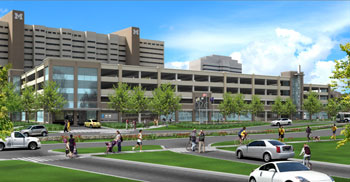
An architectural drawing of the proposed Fuller Road Station. (Image links to city of Ann Arbor webpage on the Fuller Road Station)
The press release includes a statement from mayor John Hieftje, which reads in part: “After months of fruitful discussions, we received new information from the Federal Rail Administration regarding the eligibility of monies for the local match. This information altered project timing such that we could no longer finalize a proposal under the current Memorandum of Understanding.”
On the university’s side, Jim Kosteva – director of community relations – is quoted in the press release as follows: “We are optimistic the city’s drive to win additional federal and state dollars for Fuller Road Station will be successful …When the time comes, we stand ready to reengage.” [.pdf of press release]
The press release also includes the news that the university will build the parking deck it had planned for the Fuller Road Station site at a different location: “… it is acknowledged that the University will need to move forward with building a parking structure, in a yet to be determined location, near the Medical Campus to address the expected demand as employment and patient activity continues to grow.”
The university was primarily interested in the initial phase of the project, a large parking structure with more than 1,000 spaces planned.
The city of Ann Arbor’s main interest was in the second phase of the project – a multimodal transit center that city officials hope would include a new Amtrak station, bus depot and sufficient parking for those needs. That component of the project appears to be very much still in play, contingent on identifying funding.
The Chronicle has compiled a timeline overview of Fuller Road Station with links to previous coverage. After the jump, we look at: (1) the train/bus station component of the project; (2) what led UM to initially participate in the project; (3) what happened since a memorandum of understanding between the city and the university was ratified; and (4) the timing of the decision to halt the project. [Full Story]
Totter Toons: Fuller Road Station
Photos: Local Faces in Obama’s UM Crowd
When the president of the United States comes to town to give a major speech on college affordability, it’s not something we’d want to miss.
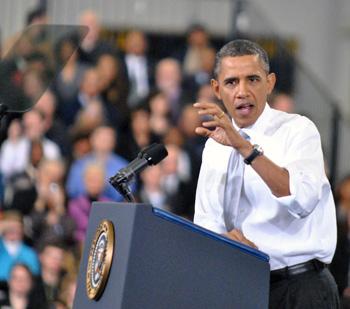
U.S. president Barack Obama, speaking at the University of Michigan’s Al Glick Fieldhouse on Friday morning, Jan. 27. His remarks focused on the issue of education and college affordability. (Photos by Mary Morgan.)
Also not wanting to miss Barack Obama’s appearance at the University of Michigan – a return visit after delivering the commencement address in May of 2010 – were dozens of other national, state and local media. Attention is heightened even more during this election year, and Friday morning’s speech was just one of many stops as Obama hit the road following Tuesday’s State of the Union address.
There will be countless reports and opinions offered on the Jan. 27 speech at UM, but we’d encourage you to approach it unfiltered, at least initially. You can watch the roughly 40-minute speech in its entirety online, or read a transcript of it here.
For Obama’s remarks almost two years ago at the 2010 UM commencement, we provided a bit of our own analysis, along with photos by Myra Klarman.
This time, we went with an eye for recording the community connections we could see at the event. And there were many – not surprisingly for a Democratic stronghold like Ann Arbor. Politicians were easy to spot, of course, but there were also educators, business owners, government workers and many others.
Over 3,000 people attended Friday morning’s speech. Here are a few of those we encountered there. [Full Story]
Column: Ann Arbor’s Monroe (Street) Doctrine
On the northeast corner at the intersection of State and Hill streets in Ann Arbor, the University of Michigan’s Weill Hall stands majestically as a landmark building, establishing the southwest corner of the UM campus.
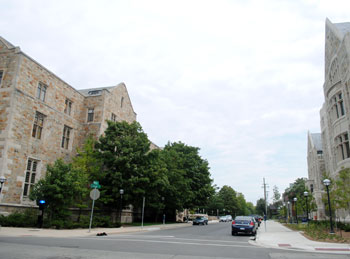
Looking east down Monroe Street, across State Street. This section of Monroe Street is flanked by two University of Michigan law school buildings: Hutchins Hall to the north, and South Hall. (Photos by the writer. )
Following State Street north up the hill towards downtown will lead you to the intersection with Monroe Street. Turn right on Monroe, and you’ll wind up at Dominick’s, a local watering hole, majestic in its own right.
One parking option for patrons of Dominick’s is that first block of Monroe Street east of State. And what better topic to discuss over a pitcher of beer, sitting at a Dominick’s picnic table, than Ann Arbor parking rates. How much should it cost to use an on-street parking space on Monroe in that one block between State and Oakland?
Here’s a different question: How much for the whole damn block? I don’t mean just the parking spaces. I mean the whole right-of-way.
That question is part of a current conversation among public officials from the city of Ann Arbor and the University of Michigan. The university is not interested in parking cars on that block. In fact, it’s the university’s desire that the thoroughfare be blocked to vehicular traffic. Permanently.
By tackling this topic, I’d like to achieve a two-fold purpose. First, I’d like to promote the daylighting of conversations now taking place out of public view. Second, I’d like to provide a rational way to approach calculating the value of city right-of-way, specifically in the general context of city-university relations.
Otherwise put, I’d like to sketch out a kind of Monroe Doctrine for Ann Arbor, which might in some ways mirror the message in the original Monroe Doctrine, set forth by President James Monroe in his address to Congress, on Dec. 2, 1823.
I’m not going to suggest including the part that talks about when “our rights are invaded or seriously menaced …” [Full Story]
UM President Gets 2.75% Raise
At its Sept. 15, 2011 meeting, the University of Michigan board of regents voted unanimously to give UM president Mary Sue Coleman a 2.75% raise, effective Aug. 1. Regent Martin Taylor, chair of the board’s personnel, compensation and governance committee, said the raise amounts to a “whopping” $15,678. He said the board would like to award a higher amount, but must factor in the state’s economy.
Coleman’s salary before the raise was $570,105. Regents had awarded a 3% raise a year ago. Her compensation package also includes $75,000 in deferred compensation, a $100,000 retention bonus, $24,500 in retirement pay, and an additional $30,850 supplemental retirement payment. Her current contract goes through July 31, 2014.
At Thursday’s meeting, Coleman said she planned to donate her raise … [Full Story]
UM Conflict-of-Interest Items Authorized
At its Sept. 15, 2011 meeting, the University of Michigan board of regents signed off on 14 items that required disclosure under the state’s Conflict of Interest statute. The law requires that regents vote on potential conflict-of-interest disclosures related to university staff, faculty or students. Often, the items involve technology licensing agreements or leases.
This month, the items related to the following businesses: Cornell Farms; Civionics Inc.; NeuroNexus Technologies Inc.; Inmatech Inc.; Vortex Hydro Energy; Rolith Inc.; Lean Therapeutics; Electric Field Solutions Inc.; Diapin Therapeutics; Arbor Research Collaborative for Health; Absolute Nano Inc.; and Michigan Critical Care Consultants Inc.
This brief was filed from the boardroom of the Fleming administration building, on UM’s Ann Arbor campus. A more detailed report will follow: [link]
In the Archives: Retrospective Lip Smacking
“In the opinion of very many persons … the word ["student"] signifies a young fellow who smokes, chews, drinks, plays billiards, and perpetrates undignified jokes,” reads an October 12, 1867 article in the University of Michigan student newspaper the University Chronicle. “But as has been said many times, the reputation of students in this respect is owing only to the exceptional few. We hope, for their sake, that they may not reap the whirlwind.”
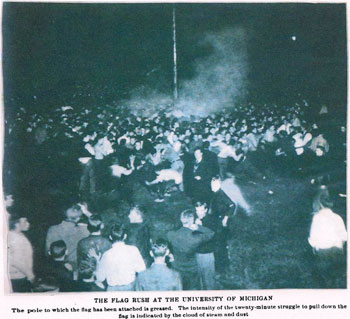
In its August 1909 article on student hazing, Hearst Illustrated magazine published A. S. Lyndon's 1908 photo of students jostling around a flagpole, intent on removing the banner.
The article concerned a developing tradition on college campuses across the country, including UM: an autumn clash between freshmen and sophomores known as “rush.”
The late 1860s appear to be when UM’s tradition of an annual October rush began. The practice would survive for decades despite hospitalizations, expulsions, and several bans against rushing by student government and university officials.
“A rush is a miscellaneous row between two classes, generally freshmen and sophomore, who meet in any of the college halls or grounds,” reads a May 16, 1868 University Chronicle piece on student slang, “and in our own institution is seldom anything more than a good-natured trial of strength between the opponents.”
The article also included slang terms for freshman hazing practices. These included “pumping,” or dousing a frosh in a public water pump, “shaving,” or a less than careful haircut, and “smoking out,” or invading a freshman’s room en masse and lighting pipes till the room was choked with smoke and the new student was nauseated. [Full Story]
In the Archives: U. of M. Too Vulgar?
Editor’s note: This column is offered a week before University of Michigan’s home football opener against Western Michigan University on Sept. 3 – as a public service to news outlets who are new to the UM football beat. It’s important to know how properly to shorten the university’s name. Nowadays, in most official communications the University of Michigan seems to use “U-M” as a shortened version of the full name. Here at The Chronicle, our preferred style is “UM” – we apparently don’t have a budget for extra hyphens. If we accidentally insert a hyphen, it wouldn’t be the end of the world. For heaven’s sake, though, there are alternatives that should absolutely be avoided – even people 100 years ago knew that.

The 1890 inaugural issue of the U. of M. Daily, later the Michigan Daily (public domain image from Wikipedia).
The University of Michigan was once disgraced with a nickname so disreputable, so slangy and vulgar, that an essay was published protesting its use. Even a newspaper in another city ran a disapproving editorial.
That nickname was “U. of M.”
In the April 1903 issue of The Michigan Alumnus, a former grad fumed against “the continued and persistent use of the compromising appellation, ‘U. of M.’” He found it coarse – unworthy of a great university.
“In the first place it is not distinctive enough, as there are several other ‘U. of M.’s,’ Maine, Minnesota, and Missouri being the most conspicuous,” he began, going on to excoriate the sloppy abbreviation.
He was not alone. [Full Story]
In the Archives: Muzzling Rabies
Editor’s Note: The Washtenaw County’s public health department web page, updated on Aug. 12, 2011, shows three cases of rabies found in Washtenaw County bats so far this year. Since 2004, most years show 2-3 cases of rabies in bats. In 2009 there were none; but in 2007, 11 cases of bat rabies were recorded. Since 2004, no cases of rabies in dogs have been recorded in Washtenaw County. This week local history writer Laura Bien takes a look back to the early 1900s, when rabies was more prevalent.
The severed head of a small white poodle was sent from Ypsilanti to Ann Arbor in the summer of 1935.
It wasn’t a grisly threat or an act of revenge. The head’s recipients were neither surprised nor disgusted. Severed dog heads were their stock in trade.
The poodle had belonged to Herbert Wilson of Ypsilanti’s northside Ann Street. The dog was “so vicious,” according to the Aug. 6, 1935 Ypsilanti Daily Press, “that even after being wounded by the officers’ rifle fire, [Officer] Klavitter had to strike him with the gun to protect himself. The blow bent the rifle barrel and the officer had to use a nearby tree limb to finish killing the dog.”
The dog had bitten 5-year-old William Himes on his right arm and leg, in an era when a dog bite could lead to an agonizing death.
Dogs in Ypsilanti that August were under quarantine, meaning that they had to be contained within the owner’s home or property. Dogs that broke loose or wandered into the street could be shot on sight by police. In earlier years, anyone was welcome to take their rifle or shotgun into the street and play Atticus Finch with mad dogs. [Full Story]
O’Dell Hired as New UM Police Chief
Greg O’Dell, former deputy police chief for Ann Arbor, has been hired as the University of Michigan’s executive director for the Department of Public Safety and the university’s chief of police. He’ll start the job on Aug. 22.
O’Dell, an Ann Arbor resident, currently is chief of police and executive director of public safety at Eastern Michigan University. He holds a juris doctorate degree from the University of Toledo College of Law and a bachelor’s degree from EMU. He is also a graduate of the FBI National Academy and the EMU school for police staff and command, according to a UM press release.
O’Dell will oversee a department that employs 80 people, including 55 sworn police officers. The campus area faces heightened security in the wake … [Full Story]
UM to Buy Land at 417 S. Division
At their July 21, 2011 meeting, the University of Michigan board of regents approved the $698,364 purchase of an 0.09-acre of land at 417 S. Division, next to the UM Institute for Social Research. A tentative closing date is set for Aug. 3 – existing leases in the 3,152-square-foot apartment building located on that lot expire in August, according to a staff memo.
A $23 million expansion of ISR’s building on Thompson Street had been approved by the board in April – they signed off on the project’s schematic design in July. At their November 2010 meeting, regents approved two other land purchases on South Division related to the ISR project: $919,425 for 439 S. Division St., which included a 3,210-square-foot apartment … [Full Story]
New UM Entrepreneurship Grad Degree OK’d
A new University of Michigan joint master’s degree in entrepreneurship – a partnership of the college of engineering and Ross business school – was approved by the UM board of regents at their July 21, 2011 meeting. The degree program has been in development for more than two years. According to a staff report on the proposal, the “primary objective of this program is to arm students with the critical multidisciplinary knowledge necessary to create new technology-focused ventures, either as stand-alone entities or within established innovative organizations. Students will learn to create and capture value from novel technologies within the context of entrepreneurship.” [.pdf of full report]
The program was developed in partnership with UM’s office of technology transfer.
This brief was filed from the regents meeting in the boardroom of the Fleming administration building on UM’s Ann Arbor campus. A more detailed report will follow: [link] [Full Story]
UM Regents OK Major East Quad Renovation
At its July 21, 2011 meeting, the University of Michigan board of regents approved a $116 million “deep” renovation of East Quad. The 300,000-square-foot residence hall – located at 701 E. University, between Hill and Willard – houses about 860 students and the Residential College. The project is part of a campus-wide ”Residential Life Initiative” first presented to regents in September 2004. Other residence halls – including Alice Lloyd Hall and Stockwell Hall on South Observatory, and Couzens Hall on East Ann Street, among others – have undergone similar renovations since then.
The pending renovation has caused concern in some quarters. At the regents’ May 19, 2011 meeting, philosophy professor Carl Cohen passionately urged regents to intercede in the renovation of East Quad … [Full Story]
North Hall Renovations Approved by UM Regents
A $1.6 million renovation to North Hall – which houses the University of Michigan’s Reserve Officer Training Corps (ROTC) programs for the U.S. Army, Navy and Air Force – was approved by the UM board of regents at their July 21, 2011 meeting. The 48,000-square-foot building, located at 1105 N. University, was originally constructed in 1900 to house the university’s homeopathic medical department. The project will be designed by the architectural firm of Smith Group, with construction set to be completed in the winter of 2012.
This brief was filed from the boardroom of the Fleming administration building, on UM’s Ann Arbor campus. A more detailed report will follow: [link]
UM Regents OK Conflict of Interest Disclosures
At its July 21, 2011 meeting, the University of Michigan board of regents signed off on 10 items that required disclosure under the state’s Conflict of Interest statute. The law requires that regents vote on potential conflict-of-interest disclosures related to university staff, faculty or students. Often, the items involve technology licensing agreements or leases.
This month, the items included purchase-of-service, research and licensing agreements, among other items. The disclosures related to the following companies and individuals: Monkey Shavers Productions, Arbor Research Collaborative for Health, Melisa Schuster, Sakti3 Inc., Reveal Design Automation Inc., 3D Biomatrix, Edington Associates, and NanoBio Corp.
This brief was filed from the regents meeting in the boardroom of the Fleming administration building on UM’s Ann Arbor campus. A more … [Full Story]
UM Raises Tuition 6.7%, Budget Grows 2.2%
University of Michigan’s tuition will increase 6.7% in the coming year for in-state first- and second-year (lower division) undergraduates, following approval by the board of regents at their June 16, 2011 meeting. (A year ago, tuition increased 1.5% for in-state undergraduates at the Ann Arbor campus.) Tuition and fees for lower division in-state students will be $6,317. Tuition for non-resident lower division undergraduates will increase 4.9%, to $18,891. Voting against the tuition increases were regents Denise Ilitch and Larry Deitch.
University officials emphasized the context for these increases: The FY 2012 budget reflects a $47.5 million cut in UM’s state appropriation to $268.8 million – a decline of 15% compared to FY 2011. The budget also includes $9.2 million in student … [Full Story]
Al Taubman Gives $56 Million Gift to UM
Al Taubman, a major donor to the University of Michigan over the years, has committed another $56 million to fund medical research at UM – completing a gift of $100 million to the university for that purpose. This gift will support work at the Taubman Medical Research Institute. UM president Mary Sue Coleman announced the news at the April 21, 2011 regents meeting. Regents later approved the renaming of the biomedical science research building in honor of Taubman.
Coleman described the research – including work on ALS (known as Lou Gehrig’s disease) and other diseases – as high risk but high reward, saying Taubman’s gift would make a tremendous difference in finding cures for those diseases. Taubman also spoke at the meeting, describing some of his experiences with the university, particularly in support of stem cell research. The research holds great promise for finding cures, he said. “That’s what today’s announcement is all about.”
The gift brings the total of Taubman’s donations to UM to $141 million – he is the largest single donor to the university. His other gifts have supported the Taubman College for Architecture & Urban Planning, the UM Museum of Art, and the office of financial aid, among others.
This brief was filed from the regents boardroom at the Fleming administration building in Ann Arbor. A more detailed report will follow: [link] [Full Story]
UM Tenure Probationary Period Extended
At its April 21, 2011 meeting, the University of Michigan board of regents approved a change to Regents’ Bylaw 5.09 that will extend the maximum allowable tenure probationary period to 10 years. It has been set at 8 years since 1944. Seven faculty spoke during the meeting’s public commentary, most of them in support of the change. Regents had previously heard from faculty – most of them from the UM Medical School – at their Feb. 17, 2011 meeting. The change does not impose the longer period, but allows faculty governing groups at UM’s various schools and colleges to extend it, if they choose.
From a memo accompanying the proposed revision: “The changing nature of scholarship, with its emphasis on interdisciplinary projects, more complex research models requiring the setting up of sophisticated equipment and laboratories, and increased regulatory and compliance requirements, increases the time necessary for completion and evaluation of initial research results. These factors, combined with the fact that many faculty members, especially those from two-career and single-parent households, find it increasingly difficult to balance their teaching and
research commitments with family obligations, have led to the conclusion that a more flexible tenure probationary period is warranted.”
This brief was filed soon after the meeting’s adjournment from the regents boardroom in the Fleming administration building. A more detailed report will follow: [link] [Full Story]
UM Regents Appoint WCHO Board Members
At their April 21, 2011 meeting, the University of Michigan regents took two actions related to the Washtenaw Community Health Organization (WCHO), a partnership between Washtenaw County and the UM Health Systems. The partnership focuses on providing services to children and adults with mental or emotional health disorders, substance abuse problems or developmental disabilities.
Each institution appoints six members to the board. In action taken on Thursday, regents reappointed two members to WCHO’s board of directors, to represent the university: (1) Martha Bloom, vice president of the Ann Arbor Area Community Foundation; and (2) Jerry Walden, who founded and directed Packard Clinic until his retirement in 2007. Both members will serve terms from April 1, 2011 through March 31, 2014.
Also at the April 21 meeting, regents approved several changes to the WCHO bylaws. The changes include: (1) removing language for the UMHS to provide money for physical health services; (2) providing for the executive committee to act on behalf of the board and for actions to be reported to the full board at its next meeting; and (3) removing Washtenaw County as the fiscal agent for the WCHO. UM’s Hospitals and Health Centers executive board approved these revisions at its March 28, 2011 board meeting. The county board of commissioners approved the bylaws without discussion at its March 2, 2011 meeting.
This brief was filed just after the meeting’s adjournment from the regents boardroom in the Fleming administration building. A more detailed report will follow: [link] [Full Story]
UM Sets 2013-14 Academic Calendar
At their April 21, 2011 meeting, the University of Michigan regents approved the calendar for the 2013-14 academic year. A memo provided to the regents stated that the university’s spring break in 2014 will run from March 1 through March 9. From the memo: “We have communicated with the Ann Arbor Public School District, which in the past often tried to schedule a winter break that coincides with the UM academic calendar. We have been informed that new state requirements will mean that AAPS is unlikely to have much flexibility about when its breaks are set.”
This brief was filed just after the meeting’s adjournment from the regents boardroom in the Fleming administration building. A more detailed report will follow: [link] [Full Story]
UM Joint Degree OK’d in Health Informatics
At their April 21, 2011 meeting, the University of Michigan regents approved a new joint master’s degree and graduate certificate program in health informatics. The degree, to be offered at UM’s Ann Arbor campus, is a two-year program of the School of Information and the School of Public Health. According to documents provided to the regents, the goal of the program is to “train a cadre of experts who will bring a human-centered approach to the development and deployment of health information technologies.” The target date to enroll the first graduate certificate students is the fall of 2011, with enrollment of the first master’s degree students in the fall of 2012.
This brief was filed just after the meeting’s adjournment from the regents boardroom in the Fleming administration building. A more detailed report will follow: [link] [Full Story]
UM Approves Millions in Infrastructure Projects
At its April 21, 2011 meeting, the University of Michigan board of regents approved several infrastructure projects. Two items related to information technology (IT) infrastructure, totaling $8.9 million. Regents authorized a $2.7 million annual maintenance and replacement program for information and technology services in fiscal 2012. The program includes three major projects: (1) replacing the networking infrastructure for UM’s data network in campus buildings; (2) replacing the Northwood Housing network infrastructure; and (3) making upgrades to campus voice systems.
Regents also approved construction of a $6.2 million data center on the north campus, located near the UM Transportation Research Institute. The facility, which will be designed by Integrated Design Solutions LLC, is being built in response to increased demand for research computing and data storage capacity. Construction is expected to be finished by the spring of 2012.
Regents authorized staff to issue bids and award construction contracts for an $11 million renovation and addition at the Michigan Memorial Phoenix Laboratory, which houses the Michigan Memorial Phoenix Energy Institute. The project includes renovating about 10,000 square feet of lab space for energy-related research, and building a 10,000-square-foot addition for administrative functions. Regents approved the schematic design at their September 2010 meeting.
Finally, regents approved a $1.3 million renovation to the UM Orthotics and Prosthetics Center, located at the Eisenhower Corporate Park West facility. The project will renovate roughly 12,500 square feet, resulting in a higher-capacity clinic space and expanded laboratory area with accommodations for new programs. A3C Collaborative Architecture will design the project, which is expected to be complete by the spring of 2012.
This brief was filed just after the meeting’s adjournment from the regents boardroom in the Fleming administration building. A more detailed report will follow: [link] [Full Story]
Balancing Ann Arbor, Detroit – and a Vision
[Editor's Note: HD, a.k.a. Dave Askins, editor of The Ann Arbor Chronicle, is also publisher of an online series of interviews on a teeter totter. Introductions to new Teeter Talks, like this one, also appear on The Chronicle's website.]
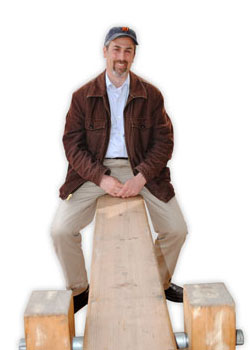
Dante Chinni, co-athor of "Our Patchwork Nation." That's a Tigers cap he's wearing, and it's not accidental.
“I don’t want to be another city. I resent the fact that we are compared to other cities when projects are being proposed.”
That was Ali Ramlawi, owner of the Jerusalem Garden on South Fifth Avenue in downtown Ann Arbor, addressing the April 4, 2011 meeting of the Ann Arbor city council. He was criticizing the Ann Arbor Downtown Development Authority, and advocating against a proposed conference center and hotel project on the Library Lot – the council voted the project down later that evening.
“Ann Arbor will change … but it won’t become Detroit.”
That was Dante Chinni, while riding the the teeter totter on my front porch last Thursday afternoon. Chinni has made it part of his job to compare communities like Ann Arbor – Washtenaw County, actually – to other places in the country.
Who is Dante Chinni? And why should Ann Arbor care what he thinks?
On his website, Chinni describes himself as a “a card-carrying member of the East Coast Media Industrial Complex.” The part of his job that lets him compare one place to another – in a statistically sophisticated way – is a project Chinni conceived called Patchwork Nation. It’s funded by the Knight Foundation. The effort has already produced a book, which he co-authored with James Gimpel: “Our Patchwork Nation: The Surprising Truth about the ‘Real’ America.”
Washtenaw County is featured in the chapter that introduces readers to the concept of a “Campus and Careers” community type. The classification, as well as a read through Dante’s Talk, confirm that mostly what defines Ann Arbor – at least for people on the outside looking in – is its place as the home of the University of Michigan. And certainly for people on the inside, it’s difficult to argue that UM isn’t currently the single most important institution in the community.
But some insiders – and by this I mean not just people who live, work and play here, but actual Ann Arbor insiders – are starting to float the question of what else Ann Arbor might aspire to be besides home to “the most profound educational institution in the Midwest.” [Full Story]
UM Regents Focus on Detroit
University of Michigan board of regents meeting (March 17, 2011): At a meeting held in downtown Detroit’s Westin Book Cadillac hotel and designed to showcase UM’s partnerships with that city, Thursday’s meeting also included some harsh words from students protesting the selection of Gov. Rick Snyder as spring commencement speaker.
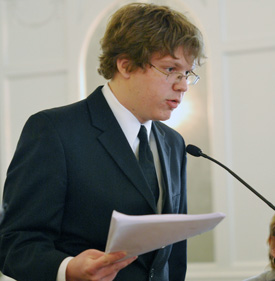
Richard Durance presented regents with a petition signed by more than 4,000 students protesting the selection of Gov. Rick Snyder as spring commencement speaker. (Photos by the writer.)
Richard Durance, an undergraduate who authored a petition against Snyder’s selection that was signed by more than 4,000 students, delivered it to regents on Thursday, saying that Snyder’s proposed cuts to K-12 and higher education make him an inappropriate choice. Zach Goldsmith, describing himself as the “angry senior” who organized protests earlier this week at the Diag, criticized regents for holding their meeting in Detroit, making it difficult for students to attend and voice their concerns.
After the public commentary, several regents defended the decision, which was made by UM president Mary Sue Coleman and did not require a vote of the board. Regent Larry Deitch said that although he’s a Democrat and personally doesn’t agree with some items in the Republican governor’s proposed budget, he endorsed the decision. And if students decide to protest at the April 30 event, he added, “that’s in the finest Michigan tradition, and we welcome it.”
Regents also heard presentations about three programs focused on Detroit: (1) the Semester in Detroit, a student-initiated program that has participants live, study and work in the city; (2) the Healthy Environments Partnership, a community-based participatory research effort that focuses on understanding and promoting cardiovascular health in Detroit neighborhoods; and (3) Revitalization and Business: Focus Detroit, a new program that’s connecting organizations in Detroit with students at the UM Ross School of Business.
Thursday’s meeting also included a unanimous vote to name The Lawyers Club dormitory in honor of Charles T. Munger, who gave the university $20 million toward renovations of the building, and a vote to approve a $39 million renovation of The Lawyers Club and the John P. Cook buildings – part of a larger expansion and renovation effort at UM’s law school.
And during public commentary – in addition to the calls for protest against Snyder – one of the speakers promoted this year’s TEDxUofM, to be held Friday, April 8 at the Michigan Theater from 10 a.m. to 5 p.m. The theme – “Encouraging Crazy Ideas” – was inspired by an August 2010 Forbes column written by UM president Mary Sue Coleman. [Full Story]
UM Law School Renovations Approved
At its March 17, 2011 meeting, the University of Michigan board of regents approved a $39 million renovation of The Lawyers’ Club and the John P. Cook buildings – part of a larger expansion and renovation effort at UM’s law school. The project will entail complete renovation of the John P. Cook building, which was constructed in 1939, along with renovations of the dormitory wing of The Lawyers’ Club, which was built in 1924 and houses nearly 260 students.
The project’s design will be handled by Hartman-Cox Architects and SmithGroup. Regents will be asked to approve a schematic design for the project at a later date.
This brief was filed from the UM regents meeting, held this month at the Westin Book Cadillac hotel in downtown Detroit. A more detailed account of the meeting will follow: [link] [Full Story]
UM Regents Name Law Dorm for Munger
At their March 17, 2011 meeting, the University of Michigan board of regents voted to name The Lawyers’ Club dormitory in honor of Charles T. Munger, who gave the university $20 million toward renovations of the building, which houses about 260 students. The north Lawyers’ Club residences will be renamed The Charles T. Munger Residences in the Lawyers’ Club. The work is part of a larger renovation and expansion project of the law school, which includes a new academic building on the corner of State and Monroe streets.
Munger is vice chairman of Berkshire Hathaway, a holding company led by investor Warren Buffett. Munger studied mathematics at UM in the 1940s and received an honorary doctorate of laws degree from the university in 2010. He previously provided funding for lighting upgrades at the law school’s Hutchins Hall and the William W. Cook Legal Research Library, including its reading room.
This brief was filed from the UM regents meeting, held this month at the Westin Book Cadillac hotel in downtown Detroit. A more detailed account of the meeting will follow: [link] [Full Story]
UM Hospital Expansion Approved
A $6 million expansion of the University Hospital medical procedure unit (MPU) was approved by the University of Michigan board of regents at their March 17, 2011 meeting. The project will create additional prep/recovery bays, procedure rooms, and storage space, and expand the patient and family reception and waiting room. The work entails renovating 2,200 square feet of existing space, and expanding the current MPU location by roughly 4,000 square feet. The project will be designed by Niagara Murano, an architectural firm, with construction scheduled to be completed in the spring of 2012.
This brief was filed from the UM regents meeting, held this month at the Westin Book Cadillac hotel in downtown Detroit. A more detailed account of the meeting will follow: [link] [Full Story]





